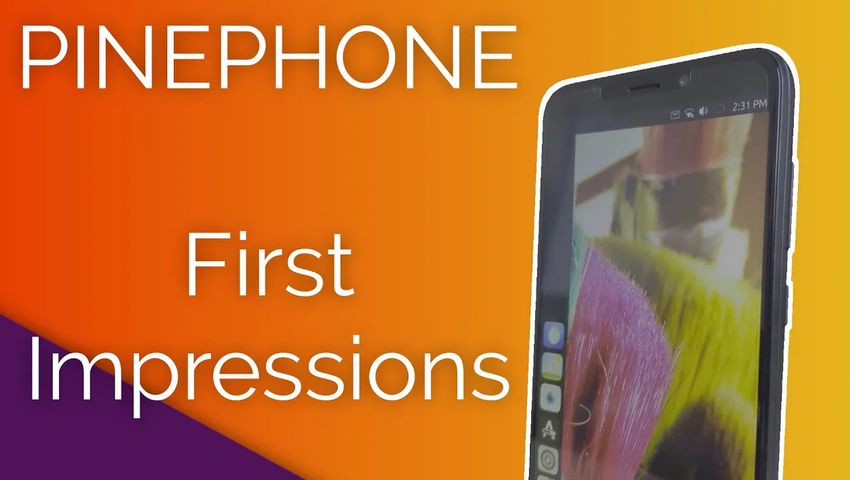11
PINEPHONE First Impressions - Love the hardware, but the software...
tilvids.comI finally had time to play with the Pinephone! It was a hard video to make: the Pinephone is nos by any means ready to be shipped to the general public, but it’s still a very interesting device. Support the channel on Patreon: https://www.patreon.com/thelinuxexperiment Follow me on Twitter : http://twitter.com/thelinuxEXP The Pinephone is, for now, mostly aimed at developers. It’s a device that will run Linux based OSes. Not Android, but full blown Linux. I’m talking Ubuntu touch or Plasma Mobile, and why not the same OS as the Librem 5, Pure OS. The PinePhone is made by ThePine64, a company that produces a bunch of Linux hardware, such as the PineBook and Pinebook Pro, the PineTime (a prototype smartwatch running Linux), and the PineTab, a tablet, running, you guessed it, Linux. The phone comes in a nice white box, with minimal branding, very reminiscent of Apple packaging. Once you open it, you get a little warning card thanking you and letting you know it’s not a consumer-ready device yet, and you get the phone itself, with a charging cable. It doesn’t come with a charging brick, but that’s not really an issue, since I don’t think anyone needs another one of these. The PinePhone itself is a big device, with a 5.95 inches display It’s not the crispest, at 1140 by 720p, but it’s bright, colors look good, and it doesn’t detract from the experience of using the phone. It weighs in at 190 grams, and it feels pretty nice in the hand, although I’m not a fan of such big phones. The screen is protected by glass, and the back plate is made of black plastic. You get a power button and volume rocker on the right side, the audio jack on the top, a usb-C port on the botton, and a frontal camera and speaker at the top, with an RGB LED. The back of the device is very simple as well, with the camera and its flash, inlaid with a little “Pine” Logo, which is a nice touch. All in all, the phone feels pretty good for a device that costs less than 200$, it definitely punches above its weight in terms of look and feel. Now, in terms of specs, the PinePhone is definitely on the low end of the spectrum, as far as phones go. It uses an AllWinner Quad Core CPU with a Mali 400 graphics chip, 2Gb of RAM and has a 5Mpx camera on the back, and a 2mpx one on the front. It’s not far off from what the Librem 5 offers, but it’s definitely no flagship device either. Still, for the price, it’s a pretty good value. Connectivity wise, the modem should support 4G and LTE networks from most carriers in the world, and the phone also has support for Bluetooth 4.0, GPS and GLONASS, and WIfi, although it’s only single band. The back cover is removable easily, just by popping out the lower right corner. It gives you access to a 3000Mah battery. Once you get the battery out, you can insert your Sim card, which is a micro sim format. Now, even more interesting, is a set of switches on the back. These are hardware kill switches for the Modem, Wifi and Bluetooth, The Microphone, the Rear and front cameras and the headphone jack. In terms of software, the PinePhone doesn’t come with any OS preinstalled. It does have PostMarket OS running a series of hardware tests. It was a bit underwhelming, although I’ll still give UBPorts a fair shake in the future. The cameras and the speaker don’t seem to work yet, and you shouldn’t let the phone go to sleep unless you know the default passphrase is “phablet”. The OS runs… alright, even though it exhibits problems when scrolling and navigating; it’s definitely not quite optimized yet for that hardware yet, and you can tell that performance wise, there is still some work to do. Now, while the OS itself works pretty well apart from some slowdowns in animations, the application situation is still problematic, and will probably be the main issue for most users. A lot of webapps are available, but nothing official. Still, judging from the interest the Pinephone and Librem 5 are gathering, and seeing the progress of libhandy, I’d be surprised if a lot of open source apps didn’t make the switch to the smartphone form factor. Battery life wasn’t fantastic, but I won’t judge that too harshly yet, since it’s very early days for this combination of hardware and software. I obviously didn’t find the apps I use everyday, like Spotify or Freeletics, or my bank’s applications, but these are probably a long way off, if they ever come. The Anbox project seems to let people run Android apps on Linux based systems , though, so it could be a nice path to try and explore later. Other software initiatives are also available, such as Plasma mobile, or postmarket OS running Phosh, the phone optimized gnome shell developed by Purism for the Librem 5. I tried both, and found them less advanced than UB Ports. More operating systems are also supported, like Sailfish OS, LuneOS, Alpine OS, or even Manjaro ARM running Plasma Mobile. I’ll need to take some more time to explore each one of these and see how they fare.



Yeah me too, I’m looking to get the librem 5 or maybe the FairPhone if it becomes available in the us.
I wouldn’t bother with the Librem 5, it’s far too expensive for what you get
Isn’t it made with better worker conditions though? If that’s why then I’m ok with it.
I am not 100% sure on that. IIRC they do source some parts from Europe and do some assembly in the US for the non-USA librem. In the end the librem 5 is more about directly supporting developers who work on the hardware AND the OS.
TL;DR
Librem = more money directly for software devs (from the Gnome project and their own team)
Pinephone = $10/phone donation to a given OS project but more widely available to people who can’t afford a more expensive phone.
Just don’t expect to swap out your android/iOS phone without issue this first generation.
Yeah no I don’t plan on using it as my daily driver, I like bleeding edge technology and I want to use android as little as possible but I get that it’s going to be a while before it remotely viable as an alternative to android/ios.
Same. It also seems like there is more Dev and community work with pine64 and purism in the mobile space than anything with android. In that the only ROMs really out there are lineage and graphineOS kinda, but now we have pureOS, mobian, postmarketOS, Ubports etc making real gains. So looking forward to the amazing community building around these devices.
It’s been so long since android has been innovating for the users, meanwhile linux never stopped, in fact it’s sped up. I believe as time goes on, while app support will probably not be as amazing I do think that mobile linux will allow more innovative user experiences and control and privacy.
Exactly. I am personally looking forward to fedora silverblue mobile ha I should be mostly set when I get my librem. The only app I am really missing is a replacement for newpipe (YouTube).
I’m looking forward to kde plasma mobile or manjaro mobile (looking it up after posting seems to be like manjaro ARM instead of a specific mobile system but it’s still interesting to see). I love the idea of running the same thing on my phone and pc. It’s like what microsoft tried to do but instead of a massive corporation it’s run by a bunch of nerds. I can’t wait to see what a whole kde system can do that an android app like kde connect couldn’t do.
You can even buy the Librem 5 USA which includes extra Freedom ™. But seriously, their Mastodon instance is for “free speech”, so they are far too right-wing for my taste.